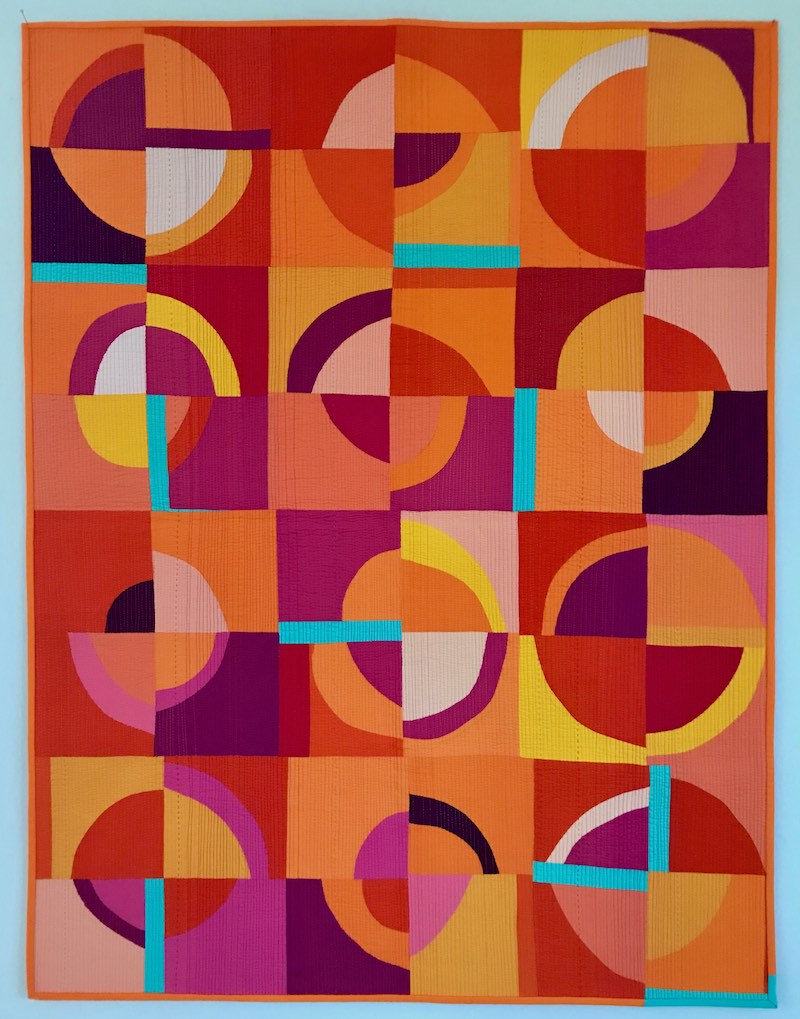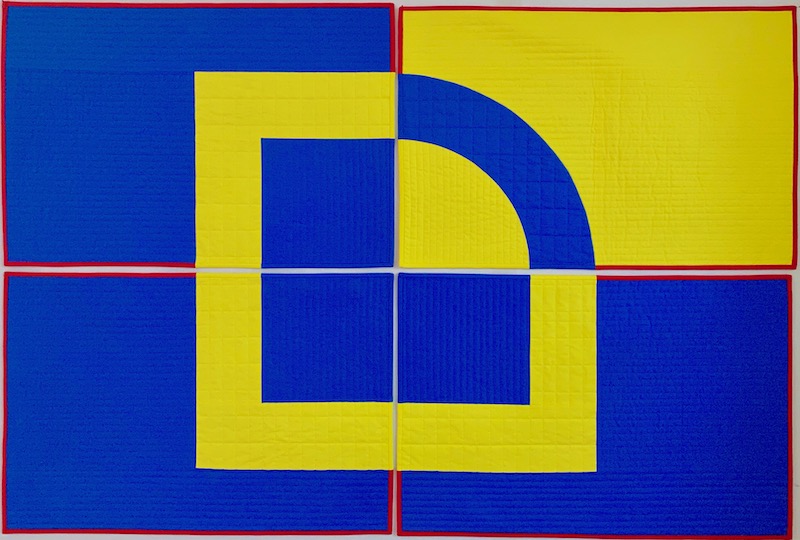Michelle Wilkie sets apart from the crowd with her clean and simple lines along with colors that engage the viewer in her textile art. Achieving the seeming simplicity of minimalist design is a complex process that Michelle immerses herself in to complete these precisely planned compositions. Her improvisational quilts, on the other hand, spring from unplanned experiments. She adds, subtracts and alters elements to create a cohesive work of art. Whether minimalist or improvisational, Michelle’s quilts speak with strong, balanced color.

How did start designing quilts? Always an artist, or was there a “moment”?
I was always an artist but my preferred medium was chalk pastels and pencil. I remember drawing and winning an art competition in elementary (primary school). It wasn’t until 8 years ago that I thought about making pillow covers which led to buying a sewing machine and very quickly to modern quilts. I have always designed my own quilts, and seldom use a pattern from someone else.
What is it about the modern quilt aesthetic that appeals to you?
It’s not modern quilting specifically that appeals to me. It’s simplicity, balance and color. For example, I gravitate towards Bauhaus and American Minimalist artists. I like the clean and simple lines in furniture with pops or interesting uses of color reflect that style. Also, I love looking at architecture with simple, stunning lines and use of geometry. So, quilts that represent simplicity, balance and use color, I like as well.
As an Amazon Associate I earn from qualifying purchases. Read more about our affiliate linking policy.
What inspires you to create?
I love to translate what I see around me and, more recently, my emotions into my quilts. My favorite part is taking a design I see in my head through to creating the quilt top. If I get into a creative rut, trying something new, experimenting without a plan, helps to rejuvenate my creativity. For example, recently, I was attending a Japanese wood block printing class at Penland School of Crafts or seeing inspiration in paper collage and wondering what that would look like if I created it as a quilt.

Does an idea inspire a work of art, or do the materials launch an idea?
All my quilts tend to be driven from an idea. It is not uncommon that the design forms mostly in my head even before I can get it down on paper (or computer). I use the drawing to work out the method to create the top in fabric. Technique and materials are always choices I make that will make the quilt a reality.

When it comes to creating, are you more of a planner or an improviser? Tell us about your minimalist quilts. How do you decide which elements are key to the success of a design?
I am both. As an artist, I create, mostly, in two styles, minimalist and improvisational quilts. Minimalist quilts take a lot more planning/designing than people think. My minimalist quilts still need to represent my inspiration or tell a story while maintaining the simplicity. I think about the shapes, the interaction with the space they are in as well as the use of color. The whole quilt matters – the design, how its translated into the quilt top, the quilting design including thread color and binding choices. On the other hand, improvisational quilts allow exploration and I usually create them from unplanned experiments. They evolve through minimal constraints and constant addition, review and editing.

How do you get unstuck creatively?
I do a couple of things to get unstuck. One, I experiment to get out of my own way, especially if I am stuck on a project. Second, I try something new (kind of experimentation, but not in quilting). For example, I might try printmaking, drawing or photography. Lastly, I was traveling (before COVID). When I go to new places and get out of my routine, the new things I see almost always inspire me.

How do you know when a piece or project is finished and needs no additional work?
Good question. For minimalist quilts, as I design mostly in my head, the quilt is usually finished before I make it. There are tweaks along the way, surprisingly not many. I might change color depending on what I have or how it looks in real life, I might move objects around or fine tune placement, I might switch out a print if the combination is not working. I do all of this review on a design wall. For me it’s about asking if it looks right, is it balanced. I have a feeling when it is right. Improvisational quilts I design purely on the design wall and again it’s the feeling of knowing when its right, taking into consideration color, placement, balance and size.

What do you do to develop your skills? How do you get better at what you do?
Experimenting and practicing something are the key ways I develop my skills. I am not afraid to try any technique if that’s the right thing to make the idea a reality.
Do you think that creativity comes naturally to people, or do you think creativity is a skill that people can learn?
I think it depends on the person. I think some people are naturally creative and for others it is a skill they can learn with practice. Even if you are naturally creative, practice is still important, too.

Do you have a dedicated space for creating? If so, what does it look like?
Yes, I do have a dedicated space for creating. I use our bonus room above the garage. I have areas in my studio which I think have a good flow for making. My space has a relaxation/social corner with sofa, chairs and coffee table; great storage for books, fabric and quilts; a big design wall; cutting and ironing area and then a dining room table set up with two sewing machines that I can also use for sew days with friends. The three things I hope to change one day: change the walls to white (it’s a light yellow right now), put wood floors in instead of carpet and add more recessed lights.

How do you organize your fabric and creative supplies?
Fabric accessibility and order are important to my creative process. I store all my fabric on shelves wrapped around comic book boards. I have 5 areas for fabric: prints organized by color, fabrics by my favorite designers (by color not by line), linens and non-quilting cottons, an area for just solids and lastly scrap bins. The scrap bins for prints and selvedges are organized by neutral, warm and cool colors; solids are organized by colors and neutrals. I also have a system or place for other creative supplies. Everything has a home.

What are the indispensable tools and materials in your studio? How do they improve your work?
I am not particularly tied to many tools. I use what I need to get the idea to become real. The things I am thankful for as they help my design/creative process are a large design wall, the sewing space (dining room table + sewing machines) and then my quilty journal.

Do you use a sketchbook or journal? How does that help your work develop?
I have two journals. The first journal I use to sketch out my ideas and the second one is a journal for my quilts. I really just use both as methods of documentation. The quilt journal is helpful to remind me how I completed a quilt, along with my steps so if I want to repeat it or need to write a pattern all the detail is available.
What plays in the background while you work? Silence? Music, audiobooks, podcasts, movies? If so, what kind?
Usually silence but sometimes I will put on music or a podcast. Right now, if I put something on, it’s “Best of David Bowe” and “Lisa Congdon’s Sessions” respectively.

Tell us about your website. What do you hope people will gain by visiting?
I do have a blog (https://factotum-of-arts.com/) and artist portfolio (https://ideadesigncreatequilt.com/portfolio/), but I really have not been great at keeping either updated regularly. I tend to use Instagram more these days. Community is important to me, so I use my Instagram feed (https://www.instagram.com/ml_wilkie/) for that community and connection. I like to share my process with people more to keep me on task, and to get feedback if I need it.
Do you lecture or teach workshops? How can students/organizers get in touch with you to schedule an event?
I do lecture and teach workshops, though I have taken time off during COVID. My focus needed to be on my day job and helping with my son’s remote learning. My favorite classes to teach are usually around designing your own quilts and taking the idea into a quilt, and I love teaching improvisation classes. I would love to do a multi-day class someday that really starts at the beginning and gets you well on your way to completing a quilt. The best way to get information on me is via email (ml_wilkie@hotmail.com).
Interview posted November 2021
Browse through more modern quilt inspiration on Create Whimsy.
